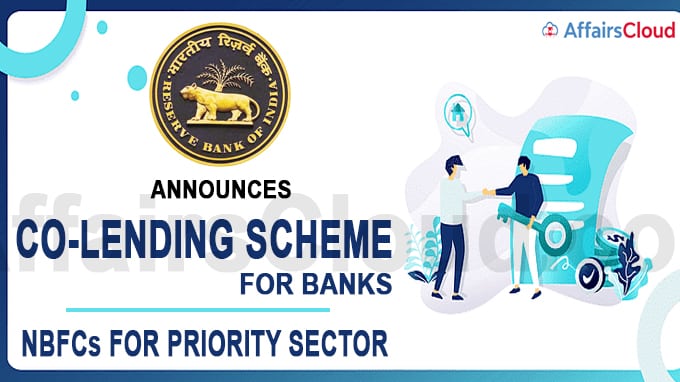 On November 5, 2020, the Reserve Bank of India (RBI) has revised the loan scheme of the Co-origination Model between Banks and Non-Banking Financial Companies – Non-Deposit taking – Systemically Important (NBFC-ND-SIs) launched in September 2018 with the improved”Co-Lending Model (CLM)“.
On November 5, 2020, the Reserve Bank of India (RBI) has revised the loan scheme of the Co-origination Model between Banks and Non-Banking Financial Companies – Non-Deposit taking – Systemically Important (NBFC-ND-SIs) launched in September 2018 with the improved”Co-Lending Model (CLM)“.
The Scheme CLM helps banks to provide loans along with NBFCs (Non-Banking Financial Companies) including HFCs (Housing Finance Companies) for priority sector borrowers based on a prior agreement.
- This revision has been made to provide greater operational flexibility to the lending institutions in order to improve credit flow to the unserved and underserved sectors of the economy at an affordable cost.
- Notably, under priority sector norms, banks are mandated to lend a particular portion of their funds to specified sectors, like weaker sections of the society, agriculture, MSME (Micro, Small & Medium Enterprises) and social infrastructure.
Key Points:
-The co-lending banks will take their share of the individual loans on a back-to-back basis in their books while NBFCs are required to retain a minimum of 20% share of the individual loans on their books.
-Both entities need to formulate Board approved policies for entering into the CLM and place the approved policies on their websites. On the basis of this Master Agreement will be prepared including terms and conditions of the arrangement.
-The CLM will not be applicable to foreign banks (including WOS) with less than 20 branches.
-NBFCs will be the single point of interface for the customers and will enter into a loan agreement with the borrowers.
-All transactions (disbursements/ repayments) between the banks and NBFCs relating to CLM have to be routed through an escrow account maintained with the banks.
- Escrow accounts are a financial instrument in which an asset or escrow money is held by a third party on behalf of 2 other parties that are in the process of completing a transaction.
-With regard to grievance redressal, co-lenders are required to provide a suitable arrangement to resolve any complaint registered by a borrower with the NBFC within 30 days.
- If the complaint is not resolved, the borrower has the option to escalate the same with the concerned Banking Ombudsman/Ombudsman for NBFCs or the Customer Education and Protection Cell (CEPC) in RBI.
Recent Related News:
i.On September 30, 2020 The Reserve Bank of India (RBI), in consultation with the Government of India (GoI) has fixed Rs 1,25,000 crore as the Ways and Means Advances (WMA) limit for the 2nd half of the financial year(FY) 2020-21, i.e., October 2020 to March 2021. When GOI utilises 75% of the WMA limit, RBI may trigger fresh floatation of market loans.
ii.On October 1, 2020, the Reserve Bank of India (RBI) excluded six public sector banks (PSBs) from the Second Schedule of the RBI Act, 1934 following their merger with other banks with effect from April 01, 2020. The six banks are Syndicate Bank, Oriental Bank of Commerce (OBC), United Bank of India, Andhra Bank, Corporation Bank, and Allahabad Bank.
About Reserve Bank of India (RBI):
Formation– 1 April 1935
Governor– Shaktikanta Das
Headquarters– Mumbai, Maharashtra
Deputy Governors– 4 (Bibhu Prasad Kanungo, Mahesh Kumar Jain, Michael Debabrata Patra, and M Rajeswar Rao)




